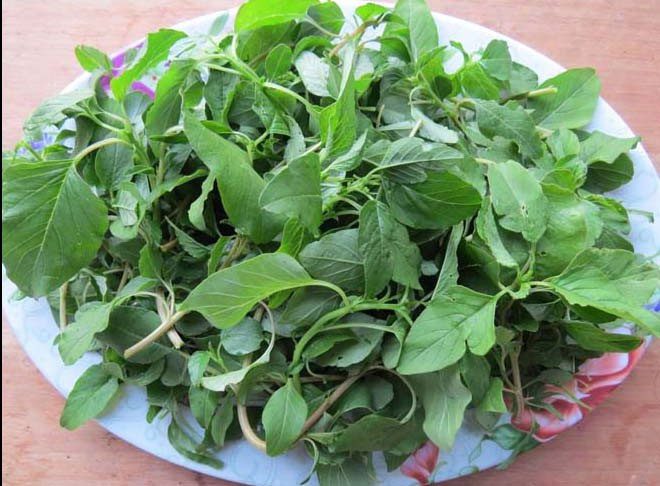Fruits and vegetables are one of the four essential food groups for a balanced meal. Their value lies in providing the body with highly bioactive nutrients, especially vitamins (Vitamin A, Vitamin C), minerals, and trace elements. Additionally, they contain organic acids and cellulose.
In developing countries, over 80% of the available Vitamin A comes from fresh fruits and vegetables in the form of carotene, and nearly 100% of Vitamin C is also provided by fruits and vegetables.
Research findings show that:
Among various vegetables, water spinach, jute leaves, and amaranth are valuable vegetables with high nutritional content, consistent levels of Vitamin A, and carotene (equivalent to 1,760 mcg% retinol), Vitamin C (179-64-52 mg), and iron content (2.8-2.5-2.1 mg%), rich in minerals, trace elements, and proteins 3-5 times higher than other vegetables (3-6g%).

Amaranth is one of the valuable vegetables with high nutritional value.
Water spinach has an average nutritional value (380 mcg% retinol; 2.8mg% Vitamin C; 1.2mg iron) which is lower than water spinach and jute leaves, but is preferred and consumed frequently throughout the year in large quantities (dozens of times more than other vegetables), making its value significant.
Seasonal herbs (such as coriander, perilla, basil, dill…) have higher and more consistent levels of Vitamin A and carotene compared to edible vegetables and sweet fruits (averaging 400-900 mcg% retinol), with perilla, basil, and yellow peppers being the highest (over 9,000 mcg%) and rich in iron (1-3mg%). Fresh herbs are used raw, preserving their high vitamin content, and they also provide valuable plant-based antibiotics.
Ripe fruits in yellow, red, and orange colors such as papaya, persimmons, watermelon, oranges, and tangerines have fairly high Vitamin A content (300-700 mcg% retinol) and are rich in iron (0.9-1.2mg%). Notably, fresh gac fruit has an exceptionally high carotene content (equivalent to 8,753 mcg% retinol). This is a valuable fruit that has garnered attention for its potential in preventing Vitamin A deficiency, as well as its antioxidant and anti-cancer properties.
Currently, fruits have become an indispensable part of family meals. Some individuals worry that green vegetables may not ensure food safety and argue that it is acceptable to reduce the amount of vegetables consumed daily or even skip them altogether, but fruits must always be included and considered as a substitute for green vegetables. While it is true that fruits are delicious and valuable for the body, using fruits entirely to replace vegetables is not scientifically appropriate.
Dr. Nguyen Trong Hung, Head of the Nutrition Counseling Department at the National Institute of Nutrition, asserts that green vegetables and ripe fruits are part of daily meals.
“They provide an excellent source of vitamins and minerals for the body. Additionally, vegetables and fruits can help us prevent and reduce the risk of certain chronic diseases,” Dr. Hung states. For example, scallions, onions, garlic, radishes, carrots, tomatoes, pumpkins, and peppers are vegetables rich in beta-carotene, Vitamin C, and fiber, which are present in higher amounts in vegetables than in fruits.
However, the expert emphasizes that not eating green vegetables and replacing them with fruits is not reasonable.
He advises, “Replacing green vegetables with fruits may be temporarily acceptable for a few meals. However, we should absolutely not do this regularly and replace our daily vegetable servings.”
The World Health Organization (WHO) recommends that everyone needs to consume both green vegetables and fruits in their diet. Furthermore, the amount of green vegetables should exceed that of fruits. In many countries, adults are advised to consume five servings of vegetables and fruits.
In Vietnam, adults are recommended to intake about 400g of fruits and vegetables daily to meet their nutritional needs. For children, this number is around 100-300g depending on their age.
We should not let personal preferences dictate the replacement of green vegetables with fruits. Fruits are also a source of energy and simple sugars. Meanwhile, we encourage everyone to supplement their simple sugar intake appropriately and avoid overconsumption,” Dr. Hung remarked.
In agreement, Master Le Thi Hai, former Director of the Nutrition Counseling Center at the National Institute of Nutrition, believes that while fruits also contain fiber, they cannot substitute for green vegetables.
“Eating too many fruits without vegetables will affect gastric juice secretion. Therefore, we need to balance our daily intake of fruits and vegetables to ensure the body receives adequate nutrition,” the expert explained.
The fiber in vegetables plays a significant role in disease prevention, primarily found in vegetables, it promotes the body’s absorption of the three basic food groups (proteins, carbohydrates, fats). If one only consumes animal proteins, the absorption efficiency in the digestive tract is only 70%, while adding vegetables can increase protein absorption efficiency to 90%.



















































